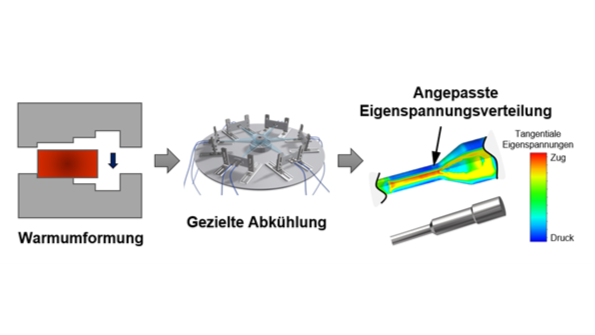Experimental and numerical modelling and analysis of microstructural residual stresses in hot formed components with targeted cooling

| E-Mail: | fem@ifum.uni-hannover.de |
| Year: | 2024 |
| Funding: | Deutsche Forschungsgemeinschaft (DFG) – Projektnummer 530125423 |
| Duration: | 30 Monate |
Highly stressed components found e.g. in drives are manufactured by hot forming due to the resulting strength, reliability and cost effectiveness. Failure cases are often linked with unfavourable residual stresses induced during production, which should be further considered for component optimization. During a collaboration with the Institute of Mechanics of the University of Dusiburg-Essen, a comprehensive knowledge base was created through extensive material characterization, FE models and experimental analysis of a reference process with an abstract specimen geometry, as well as numerical tools for understanding and modifying residual stresses during hot forming on different scales. It was shown that compressive residual stresses can be induced on the surface instead of tensile residual stresses through a specific process control and the resulting potential property improvement of hot forged components was verified. A validated single-scale FE model for the process design and a thermomechanical multi-scale FE²-model for the display of phase transformation on the microscale exist.
These tools, methods and concepts are used for the design, dimensioning and optimization of an industry-related manufacturing process and will be further developed. A shouldered shaft made of 42CrMo4 (1.7225) will be used as a demonstrator for a highly stressed hot forged component with a long shape commonly found in axles and drive shafts. Components like those only receive minor local hard fine machining at the bearing seats after hot forming. The generated residual stresses at the highly stressed component areas, e.g. due to bending, remain unchanged.
The aim of this specific numerical process design is the maximization of the life time of the shaft through a tailored residual stress distribution. The existing simulation models are to be extended with a calculation approach for a life time prediction based on the residual stress distribution present in the shaft. Afterwards the optimal process chain will be experimentally realised and the property improving mechanisms of residual stresses in components manufactured with the improved and a conventional reference process will be analysed in fatigue tests with cyclic loads. In addition the simulation models are validated with the results of the experimental fatigue tests.
Furthermore, through close examination of the component performance and analysis of the residual stress stability during cyclic bending in axles as well as pulsating torsion in drive shafts two possible use cases of the steel 42CrMo4 (1.7225) are exemplified. Thus, an optimal transferability of the project results towards a broad spectrum of industrial applications is ensured.




















